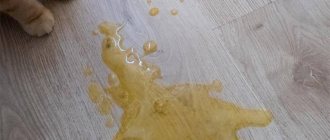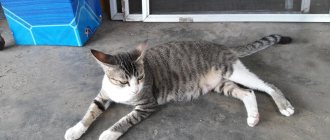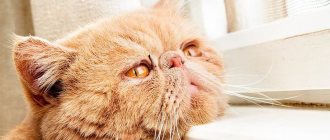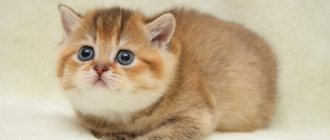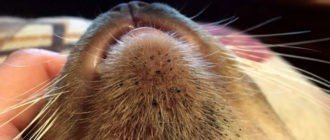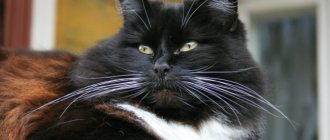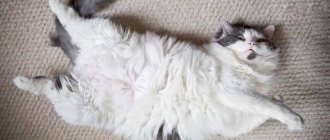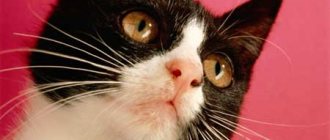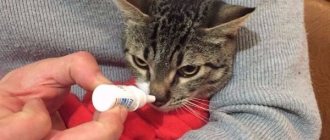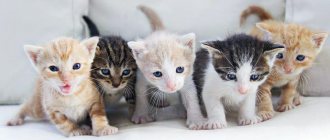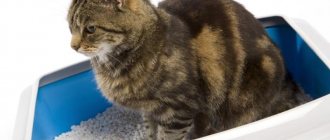18582Pavel
3
Sometimes cat owners notice that their pet begins to feel sick after eating both commercial and natural food. There are many reasons why a cat vomits after eating undigested food. And the most harmless one is overeating. Murka could simply overeat and in this way empty her stomach. Vomiting of pieces of unprocessed food can also occur if the animal has been starving for a long time. The stomach may simply not be ready to receive a significant amount of food.
But a cat’s vomiting after eating can also occur for more serious reasons. For example, a pet vomits pieces of food in the presence of chronic gastrointestinal pathology.
In any case, if a cat burps after eating for no apparent reason, then he needs a full medical examination. The veterinarian will be able to determine why the animal is vomiting after eating, and also prescribe treatment appropriate to the current condition.
© shutterstock
Vomiting, its causes and dangers
Vomiting is a complex protective process based on reflexes, with the help of which the cat’s body gets rid of dangerous and harmful substances. Vomiting is usually the main symptom of gastrointestinal problems.
Let us immediately note that an attack of vomiting, occurring once every 3-4 days, is the norm, especially in cats. However, there are still specific reasons. To understand them, you need to analyze the cat’s diet, and perhaps make it starve for a while. Most often, cats vomit from overeating - they simply eat too much and too quickly. This applies to both dry food and natural food, but dry pieces are very easy to regurgitate, especially if they are poorly chewed. Most often, those animals that regurgitate are those that live in conditions of competition for food and therefore absorb food quickly and greedily. By the way, some of them will not disdain to eat the food removed from the body again.
Animals that live together tend to eat quickly and chew their food poorly, so regurgitation is common for them.
If a domestic cat often regurgitates food as soon as it leaves its bowl, then it is overeating or this type of food is of poor quality. Economy-class food, such as Felix, Whiskas, Sheba and the like, have a poor composition and contain many harmful additives, so such food will clearly not benefit your pet.
It is advisable to purchase premium and super-premium food for your pet, and for chronic diseases - specialized lines of such food
Causes of vomiting in cats
The main causes of vomiting can be divided into two large groups: reflex irritation of the digestive organs and poisoning.
In the first case, foreign substances or excessive amounts of food irritate the organs of the digestive tract and cause a reflex reaction of rejection. The following reasons may lead to this:
- improper diet: too rich, not suitable for cats, poor consistency (sticky, rubbery food, with bones, etc.);
- ingestion of a large amount of hair when licking (especially in long-haired cats): hairballs cause mechanical irritation of the stomach and also interfere with the normal excretion of feces from the body, which also contributes to vomiting;
- parasites that mechanically irritate the liver and intestines;
- chronic diseases of the gastrointestinal tract;
- ingestion of foreign bodies - small toys, hair bands, threads, waste from a garbage can;
- seasickness - vomiting due to disturbances in the functioning of the vestibular apparatus.
In the second case, poisoning occurs with toxic substances that enter the blood, spread throughout the body, irritate the vomiting center in the brain and cause vomiting. Intoxication may have the following origins:
- waste products of intestinal parasites - kittens are especially sensitive to their effects;
- poor quality, expired food;
- chemicals: detergents, bleach, medications, indoor plants;
- infectious and inflammatory diseases leading to disorders of the gastrointestinal tract;
- chronic kidney diseases, causing general intoxication of the body;
- false pregnancy, which can occur in cats after estrus;
- brain damage: trauma, edema, increased intracranial pressure;
- stress, shock or psychological trauma.
Danger of vomiting
A dangerous consequence of vomiting is dehydration, which quickly occurs with persistent and prolonged vomiting. It is especially poorly tolerated by small kittens. An animal can quickly die from dehydration, so if vomiting does not stop, you should immediately take the animal to a doctor.
With persistent vomiting, even water is not retained in the cat’s body: as soon as the cat drinks, it starts vomiting again
It is also necessary to measure the cat’s temperature: in case of infectious and inflammatory diseases it increases, in case of poisoning and shock it decreases. In both cases, you need to go to the doctor or call him at home.
The temperature in cats is measured in the anus for 2-3 minutes, the norm is a temperature of 38 to 39 degrees
The vomit should not contain blood, mucus, have a strange color or a foul odor - in this case, you should also contact your veterinarian immediately.
Symptoms of vomiting
Many owners confuse the symptoms of vomiting with coughing, thinking that their pet vomited due to a severe cough. But it is cough that is a symptom of vomiting, and not vice versa. A normal attack of vomiting has several stages:
- The cat feels nauseous, shows anxiety, moves from place to place, licks itself, makes swallowing movements, and salivates profusely.
- The animal begins to cough, stretches its head forward, and breathes deeply and frequently.
- Contractions occur in the abdomen and throat, vomiting occurs, often at first sterile, and then with contents.
At first the cat feels nauseous, gets restless and licks its lips, and an attentive owner may already notice at this stage that the pet will soon vomit
When to contact a veterinarian
You should try to get to the veterinarian as quickly as possible in the following cases:
- The food has been removed, but the vomiting does not stop, and the animal’s condition is depressed.
- Abnormal stool.
- The animal doesn't eat.
- Worms were found in the vomit.
- The cat is sick and vomits every day.
- The smell of vomit is foul and the mass looks like feces.
- Blood impurities.
- Vomiting is accompanied by elevated body temperature and convulsions.
- The kitten is vomiting.
Types of vomiting in cats
First, let's talk about physiological vomiting, which is not dangerous to your pet's health. It could be:
- Vomiting from eating grass - cats use it to cleanse the body. If a cat ate green grass and vomited green grass, then this is normal and even healthy. However, sometimes cats quite successfully digest all the grass, and if they eat it, this does not mean that vomiting will soon begin.
Cats love green grass, with which they cleanse their bodies and replenish their supply of vitamins.
- Vomiting from psychological trauma - Some cats may react by vomiting to moving, rearranging furniture, or introducing a new pet into the house. Knowing this characteristic of a cat, it is better not to feed the animal on this day or reduce the amount of food - this will help prevent an unpleasant reaction from the cat’s body.
- Vomiting from motion sickness during long trips is quite common in cats. To prevent such vomiting, you can use mild herbal-based sedatives, and do not feed your pet for 7-8 hours before the trip.
- Vomiting from eating inedible objects - some cats tend to swallow threads, pieces of plastic, candy wrappers, hair ties and even small toys. As a rule, in such animals vomiting occurs easily and frees the body from inedible objects. However, if difficulties or symptoms of difficulty breathing occur in a cat with such vomiting, you should immediately consult a doctor.
- Vomiting from swallowing fur - sometimes cats get nervous and lick their fur especially actively, after which they may even develop bald spots on their stomachs. To facilitate the removal of fur from the body, there are special vitamins and treats, and you can also help the cat by introducing a teaspoon of petroleum jelly into the mouth.
Similar products can be used for cats of any kind, especially long-haired breeds, which often tear their hair.
Non-dangerous vomit is most often transparent, with visible and understandable contents: wool, grass, threads, pieces of food.
Vomiting after eating undigested food or dry food
This is a typical type of vomiting seen in domestic cats. The rapid pace of food absorption, large volumes and poor chewing lead to the fact that the stomach does not have time to stretch and throws the contents back. The cat may vomit immediately near the bowl or a few minutes or even half an hour after eating. The animal can then return to the bowl and ask for food again. There is only one way out - limit food portions. Dry food must be chewed so that you can hear how its pieces crunch. If the animal swallows them whole, then the likelihood of vomiting increases greatly. In addition, when washed down with water, the food actively swells in the stomach, so initially the cat needs to eat much less.
Eating greedily and quickly is the most common cause of vomiting in cats.
The author of the article has a beloved old cat of the Thai breed, which is already 17 years old. In the last 3-4 years she has been vomiting quite often, and we are very familiar with this problem. About 1-2 times a week she regurgitates dry food, which she previously swallowed without chewing. She has special, premium food, designed for good digestion, the pieces are not very hard, they are easy to chew. But the cat already has very bad teeth, so from time to time, when she is too lazy or has no time to grind the pieces, she eats them quietly, quickly and without any crunching. This process is also influenced by the presence of a second animal in our house, a young and healthy cat, who eats completely different food from his bowl nearby (for young castrated males), but looks towards the cat in order to move it away from the feeder and eat everything that lies there. Usually we follow this process and do not allow the cat to eat someone else’s food, but sometimes we get distracted and see the final scene: the cat walking away from its bowl and the cat finishing the food behind it. Therefore, the cat periodically eats greedily, quickly, without chewing, after which after 10–15 minutes, maximum half an hour, it begins to slurp and lick its lips, then runs to the floor, coughs there, and it is on the carpet (favorite place) that the entire contents of breakfast or dinner are thrown out. It looks like slightly overcooked (rarely) or not chewed food at all (usually). The cat feels guilty and immediately hides. Sometimes she doesn’t have time to reach the floor and vomits right on the bed where she sleeps. I have to clean up piles of food after her and wash her beds. It's not scary, but it's unpleasant. This happens about once a week. If you feed your cat wet food of the same line, there will be no vomiting, because it is soft and well crushed. Usually after a bout of vomiting I feed her a little less than usual. But we must give the cat his due; after burping, she never returns to the bowl and asks for more food. She arranges a diet for herself for 3-4 hours, and only then intensively asks to eat. Sometimes after an attack of vomiting he goes to a bowl of water and drinks a lot. The funny thing is that the cat, when he was young, tried to eat the food that she regurgitated. Now he has wised up and doesn’t do that anymore. Sometimes a cat also vomits hair, but this happens very rarely, about once every 2-3 months, during periods of active shedding. A young cat also vomits, but very rarely and never with food. He has two problems - vomiting grass when he eats too much, and vomiting foam with fur during active shedding. But since a cat licks itself much less than a cat, it also vomits its fur literally a couple of times a year and little by little. And the pet regurgitates the grass in the warm season, when we walk with him on a harness, and he absorbs the grass in the quantities his body needs. It can be concluded that young cats have far fewer problems with vomiting than older cats. And it is better to switch old cats to wet food, this will serve as a preventive measure against vomiting.
Vomiting yellow liquid (bile)
Vomiting bile means that the animal has not eaten for more than 24 hours or the contents of the stomach have previously been completely released into the environment. Bile is released from the small intestine, liver, and duodenum. This is usually a sign that the cat is hungry and not feeling well, often accompanied by lethargy and lack of appetite. In this case, it is better to show the animal to a veterinarian.
If, in addition to vomiting, the animal has a lack of appetite and a lethargic state, then you need to take it to the veterinarian for examination as quickly as possible.
If the bile is dark yellow in color, it may be hepatic vomiting associated with a foreign body inside the body or parasites.
Persistent, repeated vomiting of bile in a pet may indicate chronic diseases of the gallbladder, liver or intestines. Fatty or stale food, overeating and swallowing large pieces of food can provoke an exacerbation.
Vomiting white foam
The appearance of white foam means hungry vomiting, which is formed due to the secretion of juice in an empty stomach. To protect the mucous membrane from an aggressive environment, a special protein is produced in the stomach, which comes out in the form of white foam.
This occurs due to long-term fasting, the presence of parasites, gastritis, chemical poisoning, etc. Vomiting with white foam, occurring 1-2 times while maintaining appetite, is not considered dangerous, but if there was more urge to vomit, it is reduced or There is no appetite, and the animal’s condition is causing concern, then a doctor’s consultation is required.
Kitten vomiting
Vomiting in kittens is very dangerous and the younger the baby is, the less chance of saving him even with qualified medical care. Dehydration has a detrimental effect on kittens and can quickly lead to death. Most often, vomiting at an early age indicates congenital disorders of the digestive system or low-quality mother's milk. Difficulties in treating cubs are associated with the unpredictable effects of drugs on the young body.
Kittens from 3 months of age are considered as adult animals and the same treatment methods are applied to them.
Other types of vomiting
Vomiting blood is considered the most dangerous and always requires medical intervention. Most often, it indicates a viral infection or an exacerbation of a peptic ulcer. Also, persistent, prolonged vomiting can cause small vessels in the digestive tract to burst. Brown blood is undigested blood, which means liver dysfunction or other dangerous diseases, so the owner of the animal will need to take urgent measures in order not to lose the pet - it must be taken to a veterinary clinic as quickly as possible.
Green vomit means problems with the pancreas, blockage of the gastrointestinal tract, which is often observed with infectious and viral diseases.
Video: Vomiting in cats - veterinarian advice
Treating vomiting at home
The simplest thing an owner can do to treat vomiting in a cat is to limit its food intake for 1–2 days. You can give the drink, but little by little, so as not to provoke new attacks. In case of dehydration, you can dilute the drug Regidron according to the instructions, which replenishes fluid loss in the body, and feed the cat with it in small portions.
You can prepare a saline solution that helps with dehydration yourself: dissolve 9 grams of salt in 1 liter of water and give your cat a teaspoon of the solution every hour
The following medications can be used at home as prescribed by a veterinarian:
- If the cat refuses to drink or take medications for dehydration, then an injection of Ringer-Locke solution will help.
- For persistent, incessant vomiting, antiemetic drugs will help: phenothiazine, passertin.
- Bismuth preparations will help protect the mucous membrane of the digestive tract from irritating factors.
- If a cat is poisoned, then activated carbon, enterosgel and a dropper with glucose and ascorbic acid help a lot. You can use charcoal and enterosgel yourself, but it is better to get an IV in a veterinary clinic.
- In the most severe cases, caused by infection or damage to the gastric mucosa, the doctor may prescribe antibiotics to the animal.
After solving problems with intoxication of the body or disruption of the digestive system, you need to keep the cat on a special diet for several days, or even weeks: feed it in small portions, but often, several times a day. Food should be light, crushed (in the form of puree), and meat or food based on it should be introduced into the diet gradually. Sometimes an animal needs a diet for several years or the rest of its life.
How to make your cat vomit yourself
Sometimes it becomes necessary to induce vomiting in a cat. For example, if an animal has swallowed something inedible or toxic, then in this way you can quickly remove the harmful substance from the body. To do this, you can use a home recipe: dissolve one tablespoon of salt in a glass of warm water. Give the cat this solution until it vomits. You can also add a mechanical effect - press a little deeper than the root of the pet’s tongue, while the cat should stand or lie on its side. It is important not to forget that vomiting is dangerous due to dehydration of the body, and if the vomiting process caused by the owner is prolonged, then you need to take the cat to the veterinarian. Two days of dehydration can lead to the death of a cat.
When provoking vomiting in an animal, it is important for the owner not to forget about the danger of dehydration of the pet’s body.
It is prohibited to use hydrogen peroxide to induce vomiting; it has an aggressive effect on the mucous membranes of the digestive organs and causes a chemical burn!
You cannot induce vomiting in an animal in the following cases:
- The cat drank a toxic liquid such as solvent, alkaline or acidic solution, or detergent. In this case, you need to feed your pet a tablespoon of enterosgel or a couple of tablets of activated carbon mixed in water and quickly take it to a veterinary clinic.
- The pet swallowed an object with sharp edges that could injure the walls of the digestive tract. A tablespoon of Vaseline oil and an immediate visit to the veterinarian will help here.
When to contact a veterinarian
If the animal vomits more than 3 times a day and at the same time it looks weak, sick, depressed, then you need to call a veterinarian at home or take the pet to the clinic.
Other signs indicating the need for medical attention:
- vomiting continues for several days;
- vomit contains impurities that do not resemble food debris, especially blood;
- attacks of vomiting occur regardless of food intake or on an empty stomach;
- vomiting is accompanied by additional symptoms of trouble: diarrhea, changes in body temperature, lacrimation, weakness, tremors of the limbs, etc.
In a veterinary clinic, to diagnose the causes of what is happening, the pet will be prescribed an abdominal ultrasound, x-ray, urine, blood and feces tests.
In a veterinary clinic, to diagnose the causes of what is happening, the pet will be prescribed an ultrasound of the abdominal cavity, an x-ray, urine, blood and feces tests.
The clinic will treat a cat using the following methods and means:
- getting rid of dehydration with a dropper;
- special diet;
- in case of poisoning of an animal, take sorbents;
- for persistent vomiting - take antispasmodic and antiemetic drugs;
- taking medications that protect the liver and stomach;
- diagnosis and treatment of the underlying disease.
Preventive measures
As you know, it is much better to prevent a disease than to treat it. To prevent vomiting in your pet, the following simple rules will help:
- The cat’s diet should consist of high-quality food or natural products, balanced in vitamin and mineral composition;
- vaccinate your pet once a year;
- carry out deworming once a quarter, especially if the cat walks outside or eats raw meat;
- Brush your cat regularly, helping to get rid of hair that he would otherwise swallow when licking;
- keep bedding, beds, bowls and other animal accessories clean;
- hide from cats small objects that are attractive to them that can be swallowed;
- Carry out regular preventive examinations of the animal at the veterinarian.
Preventing theft and eating food inappropriate for a pet from a human table can also be considered as vomiting
When a cat vomits, the owner is required to pay attention to his pet and try to distinguish harmless vomiting from a symptom of a serious illness. Remember that the best method of dealing with a problem is its prevention. In this case, the easiest way would be not to overfeed the cat, provide it with psychological comfort, and also remove from the environment all substances and small objects potentially dangerous to the pet.
Diagnosis of pathologies
The help of a specialist is absolutely necessary if your pet experiences nausea for more than a day or every day.
The veterinarian will diagnose the health condition and also monitor the condition. First of all, he will perform palpation - feeling the abdominal cavity. This will reveal compactions, congestion or tumors. At the same time, the doctor will ask the owner about the cat’s behavior in recent days, about its diet and pastimes.
If a disease is suspected, urine and blood tests will be ordered; in more complex cases, an ultrasound or x-ray will be required. After the results are ready, the veterinarian will tell you what to do if your cat vomits after eating, how and how to treat it. In rare cases (intestinal blockage, tumor), surgery may be required.
Self-diagnosis is only possible if the cat has vomited once and is feeling well. In all other cases, you need to take your pet to the hospital or call a doctor at home.
